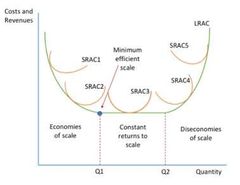![]()
![]()
![]()
Use LEFT and RIGHT arrow keys to navigate between flashcards;
Use UP and DOWN arrow keys to flip the card;
H to show hint;
A reads text to speech;
27 Cards in this Set
- Front
- Back
|
Total Revenue (TR) |
The total amount of money coming into the business through the sale of goods and services. |
|
|
Average Revenue (AR) |
Demand is equal to AR, total revenue/output. |
|
|
Marginal Revenue |
The extra revenue that the firm earns from selling one more unit of production. Change in total revenue/ change in output. |
|
|
Marginal Revenue Values |
If MR is positive, when the firm sells the product at a lower price, TR still grows so the demand curve is elastic. If MR=0, TR is maximised and the demand curve is Unitary elastic. If MR is negative, TR decreases as the price decreases so the demand curve is inelastic. |
|
|
Total Cost (TC) |
The cost of producing a given level of output. Fixed + Variable costs. |
|
|
Total Fixed Costs (TFC) |
Costs that do not change with output and remain constant |
|
|
Total Variable Cost (TVC) |
Costs that change directly with output e.g materials |
|
|
Average (total) cost (ATC) |
Total costs/output |
|
|
Marginal Cost (MC) |
The extra cost of producing one extra unit of a good, change in total cost/change in output. |
|
|
The Law of Diminishing Returns |
If a buisness decides to expand, more workers can be added relatively easily and this will lead to increase in production. However it will take a long time for the factory to expand and adding more labour only means they have less impact on the amount of goods produced as they have no machines to use. This only occurs in the SR (one or more factors of production are fixed) |
|
|
The relationship between SR and LR cost curves. |

SRAC curves are U-shaped due to the law of diminishing returns whilst LRAC are U-shaped due to economies and diseconomies of scale. |
|
|
Economies of scale |
The advantages of large scale production that enable a large business to produce at a lower AC than a smaller business. |
|
|
Diseconomies of Scale |
The disadvantages that arise in large buisnesses that reduce efficency and cause AC to rise. The firm experiences decreasing returns to scale. |
|
|
Constant returns to scale |
Where firms increase inputs and recieve an increase in output by the same percentage. |
|
|
The minimum efficent scale |
The minimum level of output needed for a business to fully exploit economies of scale. |
|
|
Internal economies of scale |
An internal economy of scale is an advantage that a firm is able to enjoy because of a growth in the firm, independent of anything happening to other firms or the industy. |
|
|
Technical economies (Internal economies of scale) |
These arise as a result of what happens to the production process: Specialisation, R&D, Capital investment. |
|
|
Financial economies (Internal economies of scale) |
Large firms have a greater security because they have more assets and are therefore less likely to be forced out of business overnight. It is easier for them to obtain finance and interest rates will be lower on loans etc. |
|
|
Risk bearing economies (Internal economies of scale) |
Large companies are able to operate in a range of different markets, producing different products which means that if one area fails, the entire business will not collapse. |
|
|
Purchasing economies (Internal economies of scale) |
Buying in bulk and distribution (preferential rates from transport companies). |
|
|
External economies of scale |
An external economy of scale is an advantage which arises from the growth of the industry within which the firm operates, independent of the firm itself. |
|
|
Labour (External economies of scale) |
Business established in an area with other successful firms from the samen industry find that labour tends to come to that area if they want a job in that industry. |
|
|
Support services (External economies of scale) |
Businesses who provide products or services for large business will naturally move to the area where those businesses are based, which reduces transport cost/time delays for the business. |
|
|
Management (Diseconomies of Scale) |
Coordination, control and communication. |
|
|
Normal Profit |
The return that is sufficent to keep the factors of production committed to the business. In economics, costs include the level of profit needed to keep the producer in the market and to cover the opportunity cost. |
|
|
Supernormal Profit |
The profit is greater than normal profit, this occurs where AR>AC or TR>TC. |
|
|
Supernormal Profit |
The profit is greater than normal profit, this occurs where AR>AC or TR>TC. |

